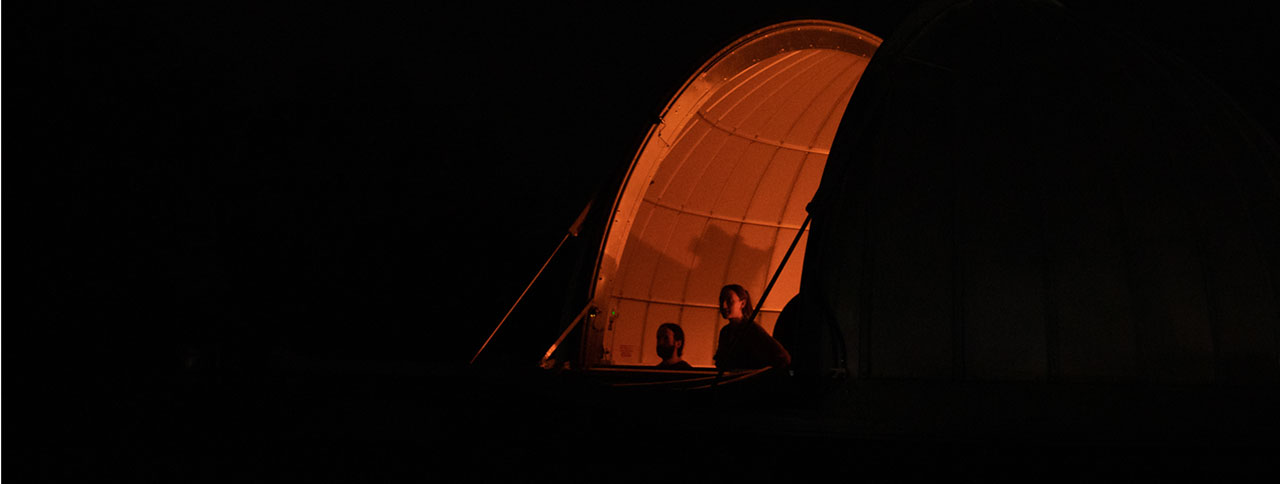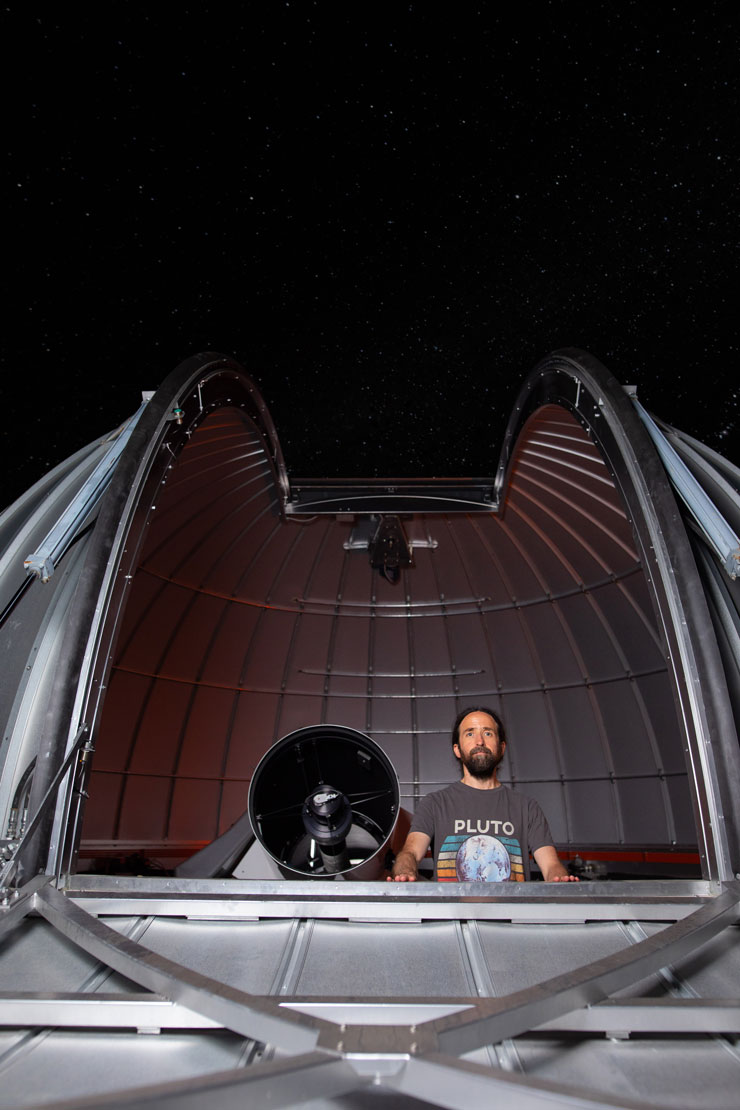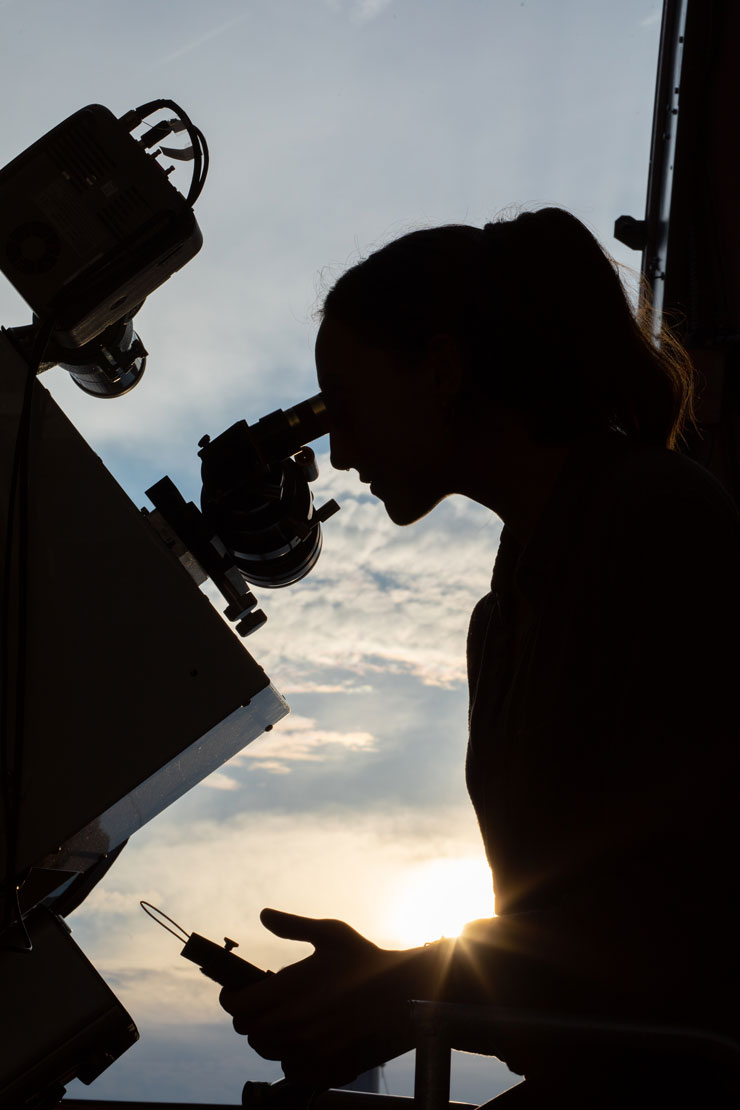
Star Power: Chambliss Observatory brings astronomy program into total alignment
BY ASH NAVE '17

Like the brightest stars in Orion’s belt, good things come in threes. This year marks the fifth anniversary of the naming of the Carlson R. Chambliss Astronomical Observatory, as well as the end of a once-in-a-lifetime student research program and the beginning of a planetarium renovation that will benefit all future stargazers.
Dr. Carlson R. Chambliss
A professor emeritus of physical sciences, Chambliss first joined the KU faculty in 1970 and served as an astronomy professor for 33 years. A member of the American Astronomical Society and International Astronomical Union, Chambliss has been an advocate for research opportunities at the university for more than a half-century.
“We have tremendous possibilities at Kutztown, more so than many places,” says Chambliss. “We’ve held two national amateur astronomy conventions here and have had some really good astronomy students over the years.”
From initiating the Chambliss Awards that recognize the highest achievement in scholarship for faculty and students to establishing the C.R. Chambliss Scholarship, which provides financial support to physical sciences students, Chambliss believes in the power of giving back to progress forward.
Even after his retirement in 2003, Chambliss has given back to the university in ways that have helped students and faculty pursue beneficial research opportunities.
In 2018, the KU astrophysics group was in the middle of a $113,000 research project, funded by the National Science Foundation. They were working with the exoplanet discovery project Kilodegree Extremely Little Telescope when the observatory’s dome stopped working.
Chambliss donated the funds to purchase a new dome, and in 2019, the university officially named the observatory after him. Now, the observatory continues to have a profound impact on the research community.
Located at the top of Grim Science Building, the observatory, originally called the Gruber-Knedler Planetarium and Observatory, was built in the 1960s and first introduced to the world by Chambliss himself in a 1971 issue of Sky & Telescope magazine. In the article, Chambliss explains how KU’s astronomy program grew significantly after the observatory and planetarium were completed.

Building community
Dr. Phill Reed ’03, (pictured above), professor of physics and astronomy at KU is currently the planetarium and observatory director and one of Chambliss’ biggest supporters and closest friends.
A member of the TESS Follow-up Observing Program, a large working group for NASA, Reed is adamant about including observatory and planetarium research in his curriculum.
Students in Reed’s astronomy courses, like his 200-level course on exoplanets, are guaranteed opportunities for hands-on observatory and planetarium research experience, such as helping Reed discover new exoplanets.
In fact, Reed and 16 students have discovered 29 exoplanets at the Chambliss Observatory, resulting in 15 publications. One is the exoplanet named KELT-23Ab, a planet 408 lightyears from Earth.
Like Chambliss, Reed understands the powerful role that the observatory and planetarium play in helping students evolve as researchers as well as bringing together the local community.
Faculty outside the physics department, such as art and photography, have even incorporated observatory research into their lectures. They’ve used the observatory for astrophotography projects, which is a creative experience that allows students to capture photos of stars, planets and other galaxies, while computer science majors continue to use the planetarium to display their final projects.
Reed says that astronomers from other institutions also travel to KU to utilize the space. And the planetarium, located on the first floor of Grim Science Building, hosts a series of public events each semester that allows the local community to experience an interactive show. Campus visitors typically include school field trips, Cub Scout groups, senior living programs and more.
"What’s amazing is that we’ve never advertised the planetarium shows to schools. These community organizations have always signed up through word of mouth,” Reed says.
Reed also says that these planetarium visits are a recruitment tool for prospective college students interested in becoming researchers.
“It’s a great opportunity for middle and high school students to see our own research here on campus, which is why it’s important that we keep these facilities up to date.”

New equipment and renovations
Because of the planetarium’s importance to the community, it was time for it to get a facelift, as well, Reed says.
Chambliss again contributed toward the $250,000 needed for new equipment. The project includes the installation of a high-resolution, multiprojector digital planetarium system called the Digitalis AEthos, and is expected to be completed in late summer and fall 2024.
With its high brightness, vivid color, and excellent projection quality, the planetarium will give future audience members a fully immersive planetarium experience, even more than it already does.
The new equipment will also provide high-resolution data sets of the Earth and solar system with incredible detail. These data sets will be invaluable information for student and faculty researchers to use in their studies.
“One of the most important aspects of KU’s planetarium is that it directly supports the research in the observatory,” Reed says. The planetarium supports the broader impact of observatory research programs, which helps KU get funding from the National Science Foundation.
“The NSF prioritizes two things for a grant – scientific merit as well as the broader impact, which ranges from things like training students and professional development, to the project’s potential impact on society,” he says.
Research in Australia
Because the observatory and planetarium present viable research opportunities and have had an overwhelmingly positive impact on the community, Reed secured a $244,000 grant from the NSF to conduct a three-year student research project in Australia in 2021, which comes to an end in 2024.
Throughout the program, Reed selected four undergraduate students each year from his exoplanet course to directly support NASA’s Transiting Exoplanet Survey Satellite (TESS), a space observatory designed to look for exoplanets in orbit around 200,000 bright stars.
When planets are first discovered, they go through a vetting process. So, before students embarked on their journey to Australia, they were trained to use the observatory and planetarium to verify potential planet candidates in the sky, in support of TESS.
Then, once the students’ data passed an initial screening process for potential planet discovery, they were invited to travel to the University of Southern Queensland, Australia, for 10 weeks in the summer.
At the world-renowned MINERVA-Australis facility, located at Mount Kent Observatory, students observed and participated in planetary confirmation as well as the characterization process of TESS, which are two steps that help verify whether their original data presented the actual discovery of an exoplanet.
“This was an amazing research opportunity for our students, to help find exoplanets with our on-campus observatory, and to then spend the summer in Australia working with cutting-edge astronomical instrumentation,” Reed says.
This article originally appeared in the 2024 Tower Magazine.





